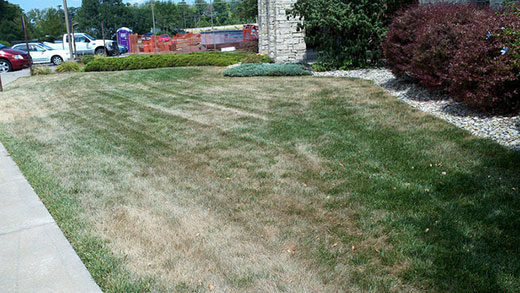
September is a good time to overseed drought-stressed lawns. | Download this photo.
September is a good time to overseed your lawn
K-State specialist gives tips on ways to thicken drought-stressed lawns
August 30, 2018
MANHATTAN, Kan. – Even with welcome August rainfall in some areas, hot, dry summer weather took a toll on many a homeowner’s lawn. September is a good time to build toward healthier, thicker tall fescue grass for next year by adding grass seed to your existing lawn, or overseeding, a Kansas State University specialist said.
Ward Upham, horticulture specialist with K-State Research and Extension and Master Gardener coordinator provided these tips:
- Start by mowing the grass short (1 to 1.5 inches) and removing the clippings. This will make it easier to achieve good seed-soil contact and increase the amount of light that will reach the young seedlings.
- Good seed-soil contact is vital if the overseeding is to be successful. Excess clippings left on the lawn, also called thatch, can prevent seed from reaching the soil and germinating. Normally we want 1/4 inch of thatch or less when overseeding. If the thatch layer is 3/4 inch or more, it is usually easiest to use a sod cutter to remove it and start over with a new lawn. A power rake can be used to reduce a thatch layer that is less than 3/4 inch but more than 1/4 inch.
- Once thatch is under control, the soil should be prepared for the seed. This can be done in various ways. For small spots, a hand rake can be used to roughen up the soil before the seed is applied.
- For larger areas, consider renting a verticut machine or core aerator from a hardware store or equipment rental business. Some have photos of the equipment online, as well as videos of people using the equipment. A verticut machine has solid vertical blades that can be set to cut furrows in the soil. It is best to go two different directions with the machine. A slit seeder is a verticut machine with a seed hopper added so the soil prep and seeding operation are combined.
- Another option is to use a core aerator. The core aerator will punch holes in the soil and deposit the soil cores on the surface of the ground. Each hole produces an excellent environment for seed germination and growth. Make three to four passes with the core aerator to ensure enough holes for the seed. Using a core aerator has the additional benefit of reducing the amount of watering needed to get the seed germinated and growing. Aeration also increases the water infiltration rate, decreases compaction, and increases the amount of oxygen in the soil.
“Of the three methods, I prefer the slit seeder for obtaining good seed/soil contact,” Upham said. “However, if watering is difficult, core aeration may be a better option. Regardless of the method used, fertilizer should be applied at the rate suggested by a soil test, or a starter fertilizer should be used at the rate suggested on the bag.”
More information is available in the K-State Research and Extension publication Tall Fescue Lawns.
A video from the Kansas Healthy Yards project shows these steps as well.
Additional links for print publications:
https://www.bookstore.ksre.ksu.edu/pubs/MF736.pdf
http://kansashealthyyards.org/all-videos/video/overseeding-your-lawn

